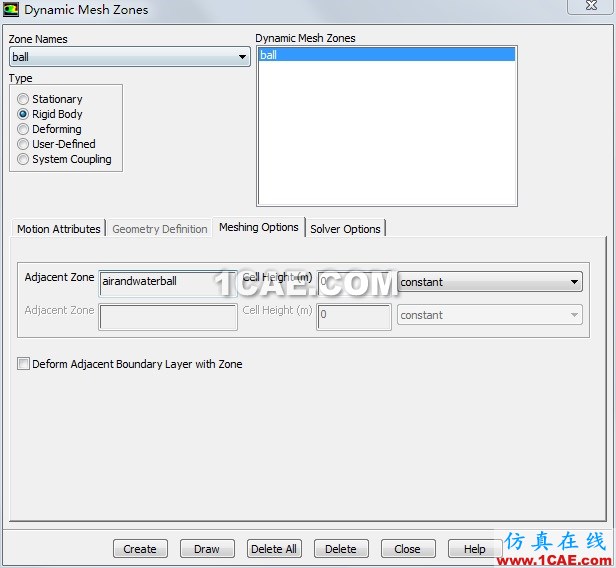fluent的cell height是什么鬼?CutCell dynamic cell zone又是什么?
2016-09-20 by:CAE仿真在線 來源:互聯(lián)網(wǎng)

經(jīng)常做6dof的同學(xué)對(duì)上述窗口中的cell height該填什么一頭霧水。現(xiàn)在我來為大家解惑。
首先要了解如下幾點(diǎn):
1、該值是在動(dòng)網(wǎng)格的meshing options中出現(xiàn)的,即與網(wǎng)格重構(gòu)相關(guān)的,用于幫助fluent 如何去做remeshing 工作
2、該值是于 Adjacent zone 出現(xiàn)的,而且還是多行的(由于只有一個(gè)adjacentzone則下面的為灰色),說明是與剛體相連的區(qū)域的某個(gè)屬性
其實(shí)這個(gè)問題是 Dynamic Mesh Update Methods 里面的重點(diǎn)問題,這個(gè)cell height表示了什么時(shí)候分裂還是坍塌網(wǎng)格,這與fluent的網(wǎng)格重構(gòu)算法息息相關(guān),這個(gè)cell height就是一個(gè)用來做對(duì)比的【理想的網(wǎng)格高度】,超過一定的程度就進(jìn)行重構(gòu),不超過就只做簡(jiǎn)單的拉伸或壓縮。
動(dòng)網(wǎng)格中,總是不斷出現(xiàn)網(wǎng)格重構(gòu),網(wǎng)格重構(gòu)則會(huì)出現(xiàn)一些被壓縮,一下被拉伸,但到了一定的時(shí)候,網(wǎng)格不能再拉伸或不能再壓縮,就要重新劃分,這個(gè)與單元高度相關(guān)。
看似很復(fù)雜,但是實(shí)際上這個(gè)值你可以不管他,即默認(rèn)為0,即表示由fluent自己決定這個(gè)標(biāo)準(zhǔn)。但是如果你劃分網(wǎng)格的時(shí)候知道這個(gè)值的具體值,填上去有助于fluent更精準(zhǔn)進(jìn)行計(jì)算。
接下來我們看看fluent文檔的翻譯:
If the rigid body zone is a face zone that is not a boundary of 【a CutCell dynamic cell zone】, specify the Cell Height for each Adjacent Zone in the Meshing Options tab.
如果剛體區(qū)域?yàn)橐粋€(gè)面區(qū)域,即他不是一個(gè)動(dòng)態(tài)剪切單元區(qū)域的邊界,那么需要為每個(gè)毗連區(qū)域指定其單元高度。
The Cell Height is the ideal cell height ( in Equation 10–15 and Equation 10–16 that is used by ANSYS Fluent to determine when the prismatic layer next to the rigid body should be split or merged with the layer next to it. If the adjacent zone is tetrahedral or triangular(四面體或三角形), the ideal height is used by ANSYS Fluent to determine if adjacent cells must be agglomerated for local remeshing. Make a selection in the Cell Height drop-down menu to specify this value as either a constant or a compiled user-defined function.
單元高度是一個(gè)理想的高度,fluent用該值來決定什么時(shí)候來分開或融合剛體附近的四邊形網(wǎng)格。如果與剛體相鄰的區(qū)域是四面體或三角形網(wǎng)格,則理想高度,則fluent用他來確定是否要聚合相鄰區(qū)域的單元。該值可以輸入常量或通過UDF函數(shù)來確定,即通過宏DEFINE_DYNAMIC_ZONE_PROPERTY 來實(shí)現(xiàn)對(duì)理想高度的動(dòng)態(tài)指定。
If you choose to use a compiled user-defined function to define an ideal cell height that varies as a function of time or crank angle, you must first define a DEFINE_DYNAMIC_ZONE_PROPERTY UDF. After you have compiled the UDF source file, built a shared library, and loaded it into ANSYS Fluent, the name of the UDF library will be available for selection in the Cell Height drop-down list.
Refer to the Fluent Customization Manual for information about UDFs.
至于什么叫【CutCell dynamic cell zone】,請(qǐng)參閱下列英文文檔:
你可以大致理解為:這是一個(gè)網(wǎng)格重構(gòu)的方法,用于重新劃分3D網(wǎng)格。為什么會(huì)出現(xiàn)一個(gè)cut呢,是因?yàn)檫@種方法會(huì)把4面體網(wǎng)格重構(gòu)成六面體網(wǎng)格,從而單元數(shù)減少了,即融合了四面體網(wǎng)格。
10.6.2.3.4. CutCell Zone Remeshing Method
The CutCell zone remeshing method is available to remesh a complete cell zone (including all boundary zones of the remeshed cell zone). This method is available for 3D simulations only. The existing volume mesh is replaced by a predominantly Cartesian mesh. Inflation layers can be added as an option. When used as part of a transient simulation, the remeshing occurs at predefined intervals and whenever the mesh quality in the cell zone is deemed poor. Examples of meshes before and after CutCell zone remeshing are shown in Figure 10.44: Unstructured Tetrahedral Mesh Before CutCell Zone Remeshing and Figure 10.45: Mesh After CutCell Zone Remeshing, respectively. Figure 10.46: CutCell Zone Remeshing With Inflation Layers shows a cut through a CutCell mesh with inflation layers.
Figure 10.44: Unstructured Tetrahedral Mesh Before CutCell Zone Remeshing
Figure 10.45: Mesh After CutCell Zone Remeshing
Figure 10.46: CutCell Zone Remeshing With Inflation Layers
During CutCell zone remeshing, a uniform Cartesian grid is locally refined using size functions, in order to resolve the initial mesh with sufficient accuracy. The resulting mesh consists mostly of hexahedral elements, which reduces the cell count compared to unstructured tetrahedral meshing. Additional element types are used near the boundaries to closely resolve complex shapes. The remeshing takes place at regular intervals, or whenever the mesh quality deteriorates due to mesh motion.
The CutCell zone remeshing method not only replaces the volume mesh, it also replaces the complete surface mesh of the remeshed cell zone. Consequently, this method can only be used to remesh cell zones that are either stand-alone zones or are only connected to other cell zones through non-conformal interfaces. If inflation layers are added to a CutCell mesh, the inflation layers are grown from the remeshed surface mesh, and the CutCell mesh is morphed such that it smoothly matches the cap surfaces of the inflation layers.
The CutCell Zone remeshing method option is available in the Remeshing Methods group box. Note that the CutCell Zone remeshing method does not use any of the parameters specified in the Mesh Method Settings dialog box. The parameters used to control CutCell Zone remeshing are specified in the Dynamic Mesh Zones dialog box when setting up the zone and boundaries.
For more information about CutCell meshes, see the Fluent Meshing User’s Guide.
10.6.2.3.4.1. Applicability of the CutCell Zone Remeshing Method
The CutCell zone remeshing method can be applied to cell zones, with the following limitations:
The case must be 3D.
The cell zone cannot be conformally connected to other cell zones; that is, a CutCell zone must be a stand-alone cell zone, or can only be connected to another zone through a non-conformal interface. In the latter case, the non-conformal interface is cleared before the remeshing and automatically recreated after the remeshing.
Note that the CutCell zone remeshing method can be applied to cell zones that contain adapted cells.
In parallel, all cells of the remeshed zone will be automatically migrated to and remeshed on a single CPU. Consequently, the machine memory will limit the size of the zone that can be remeshed. The mesh is automatically repartitioned after the remeshing.
In addition to the limitations listed previously, you should also note the following with regard to CutCell zone remeshing:
Internal coupled walls, such as baffles, are discarded during the remeshing. The method is designed to primarily remesh cell zones with a single interior zone.
Interior jump boundary condition zones (for example, fans, porous jumps), are discarded during the remeshing.
Conformal periodic boundary conditions are not maintained after the remeshing. Any existing conformal periodic boundaries on the zone being remeshed should slit and replaced with non-conformal periodic boundaries.
If the zone being remeshed contains multiple interior zones prior to the remeshing, all interior zones will be collected into a single interior zone during the CutCell zone remeshing.
10.6.2.3.4.2. Using the CutCell Zone Remeshing Method
In order to apply CutCell zone remeshing to a cell zone, begin by enabling the CutCell Zone option in the Remeshing Methods group box in the Remeshing tab of the Mesh Method Settings dialog box (see Figure 10.33: The Remeshing Tab in the Mesh Method Settings Dialog Box). Next, use the Dynamic Mesh Zones dialog box to create a deforming dynamic zone for the cell zone (see Deforming Motion). Then enable CutCell in the Remeshing Options group box and enter the relevant remeshing parameters, including: the maximum mesh size for the Cartesian cells; the global size function growth rate; the minimum orthogonal quality and remeshing interval to control the remeshing frequency; and the optional global inflation layer settings.
ANSYS Fluent allows you to specify either a soft or a mesh-based size function to control how the Cartesian mesh increases in size from the boundary toward the interior of the cell zone. For the soft size function, you specify a maximum mesh size for each boundary zone of the CutCell cell zone. When you use the mesh-based size function, ANSYS Fluent analyzes the existing mesh to evaluate the necessary mesh refinement at the boundary. See step 4 of Stationary Zones for more information about these size functions. You have control over the size function types and parameters by defining the boundary zones as dynamic zones. If no boundary zone adjacent to the CutCell zone is defined as a dynamic zone, ANSYS Fluent will automatically apply mesh-based size functions to each CutCell boundary zone and use the global growth rate entered for the cell zone to control the remeshing.
Note that the size functions used by the CutCell zone remeshing method are unrelated to the size function used for local cell remeshing (as described in Local Remeshing Based on Size Functions).
ANSYS Fluent allows you to add inflation layers to a CutCell mesh in order to better resolve wall-bounded flow features. After enabling Inflation Layers under the CutCell Zone Parameters for the CutCell cell zone, you can specify the global inflation parameters in the Inflation Settings dialog box. There are two types of inflation layers available: a constant type, where you can specify the constant height of the first layer; and an aspect-ratio type, where the first layer height is locally evaluated based on the specified aspect ratio. The latter is recommended and used by default since it is more robust and generally produces higher quality CutCell meshes. By default, the inflation settings specified apply to every boundary of the cell zone. If you would like to specify different inflation settings for different boundaries, you can define these boundaries as dynamic zones and enable Zonal Inflation Layer Control. Note that the Number of Layers, other than 0, has to be the same on all boundary zones. If different numbers of layers are specified on different boundaries, ANSYS Fluent will only inflate up to the largest common number specified. By setting the number of layers on a boundary zone to 0, you can locally suppress the growth of inflation layers, however, note that the transition is handled by stair stepping and adding wedge elements, which tends to generate skewed elements for small layer element heights.
The cells that contain hanging nodes / edges as a result of the CutCell zone remeshing are automatically converted to polyhedral cells. See Limitations for details about limitations associated with polyhedral cells.
It is recommended that you first manually apply the CutCell zone remeshing method (as described in the section that follows) and inspect the mesh before using the method as part of a transient simulation, as this allows you to evaluate if your remeshing parameters are suitable before running a calculation that is computationally expensive.
10.6.2.3.4.3. Applying the CutCell Zone Remeshing Method Manually
Although the CutCell zone remeshing method is primarily intended as an automatic remeshing method during dynamic mesh updates, you can also manually create a CutCell mesh (that is, you can remesh without running a calculation) by using the following text command:
define → dynamic-mesh → actions → remesh-cell-zone-cutcell
You will be prompted to enter the global parameters for the CutCell zone remeshing. If no dynamic zones are set up in your case, ANSYS Fluent will use the global parameters you enter and apply mesh-based size functions to each boundary of the CutCell zone. If the c
相關(guān)標(biāo)簽搜索:fluent的cell height是什么鬼?CutCell dynamic cell zone又是什么? fluent cell height fluent CutCell dynamic cell zone Fluent培訓(xùn) Fluent流體培訓(xùn) Fluent軟件培訓(xùn) fluent技術(shù)教程 fluent在線視頻教程 fluent資料下載 fluent分析理論 fluent化學(xué)反應(yīng) fluent軟件下載 UDF編程代做






